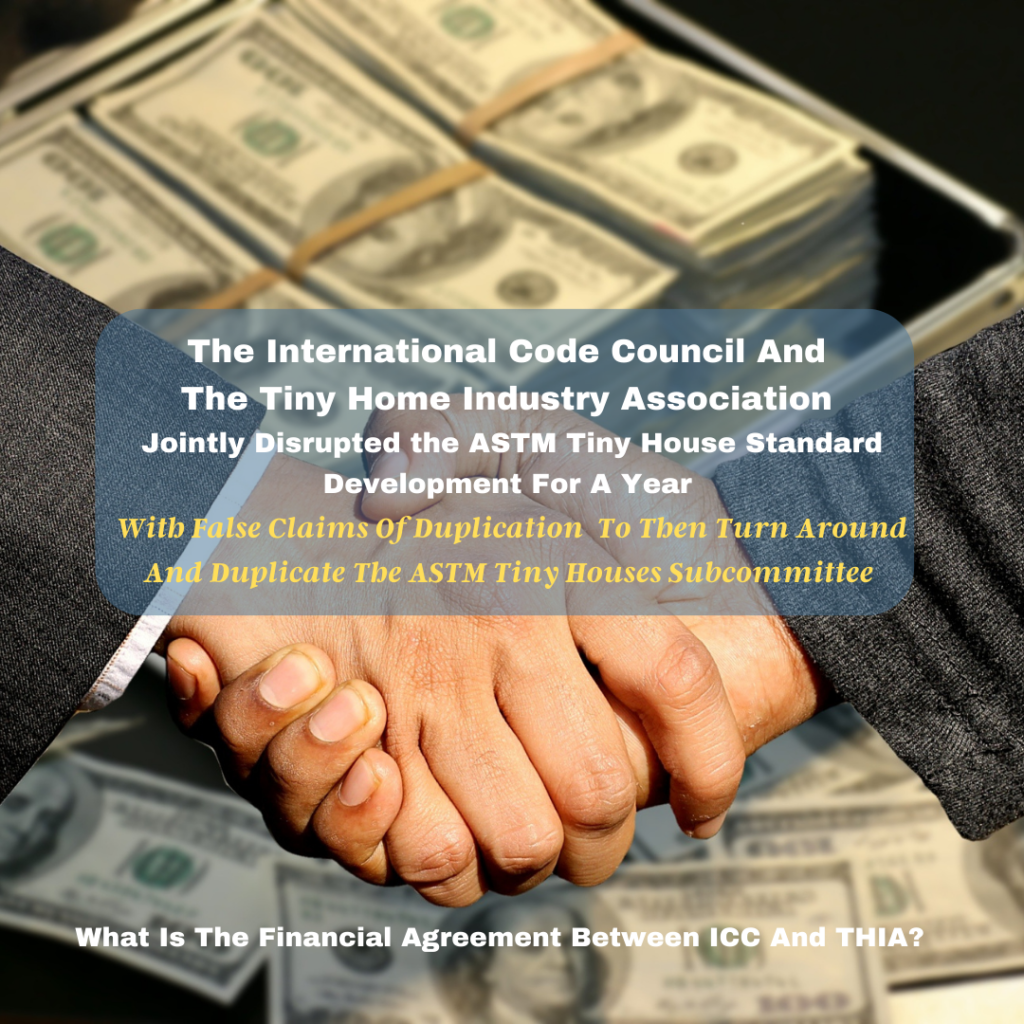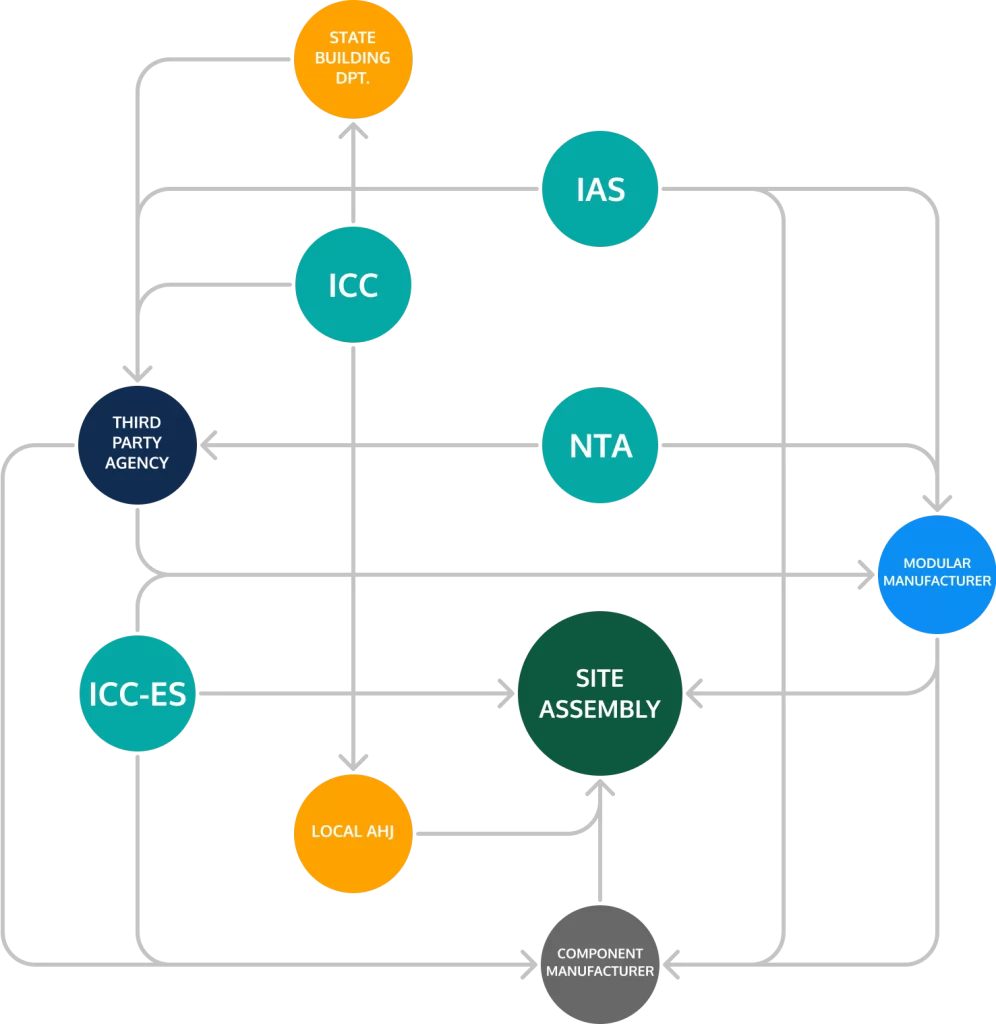Colorado Chief Building Official Files PINS Complaint Against BSR/ICC/THIA 1215-2
On May 19, 2023 Larimer County, Colorado Eric Fried, Chief Building Official filed a PINS complaint against proposed ANSI standard BSR/ICC/THIA 1215-202X “Design, construction and regulation of Tiny Houses for permanent occupancy.”
Backstory
On April 4, 2023, The International Code Council ( ICC) issued a news release and a PINS notification to announce that the International Code Council ( ICC ) and the Tiny Home Industry Association ( THIA ) were co-branding a new proposed standard for tiny houses –BSR/ICC/THIA 1215-202X “Design, construction and regulation of Tiny Houses for permanent occupancy.”
Resources
ANSI PINS Process: An Informative Summary (2022)
Due process means that any party (organization, company, government agency, individual, etc.) with
a direct and material interest has a right to participate by: a) expressing a position and its basis, b)
having that position considered, and c) having the right to appeal. Due process allows for equity and
fair play. The following constitute the minimum acceptable due process requirements for the
development of consensus.
PINS Submittal
What Could Be Possibly Wrong?
Eric Fried does a great job with describing why he and others are objecting, but in the simplest of terms, THIA and ICC fought the ASTM standards development for a year- interfered with the ability of the ASTM standards to be written for the Colorado rule-making on tiny homes on a chassis and their deadline, just to then turn around after a YEAR delay to then duplicate the ASTM Tiny House standards development already underway……….Why? -Follow The Money Trail.
Larimer County, Colorado Eric Fried, Chief Building Official PINS Complaint
Related Blog Posts

ICC/THIA Standard 1215 Design, Construction and
Regulation of Tiny Houses for Permanent Occupancy
The ICC News Release States Their New Standard Complements ASTM
”The standard complements the work of ASTM’s recently established E06.26 Subcommittee on Tiny Houses by combining existing criteria for tiny houses used for permanent occupancy into a single, referenceable location. ”
In truth, the new ICC/THIA standard does not complement ASTM, it competes with the ASTM Tiny House subcommittee E06.26.
The ICC News Release Lists The Names Of The Individuals That Disrupted ASTM
”Ryan Colker, Code Council Vice President of Innovation, David Tompos, President of ICC-NTA, and Brad Wiseman, CEO and Board Chairman of THIA, are members of this ASTM subcommittee and will work alongside other members to ensure that the Code Council and ASTM efforts avoid overlap and complement each other, in addition to providing consistency and clarity for tiny house builders, code officials and municipalities on corresponding codes and standards. ”
These are the very individuals that worked against the ASTM tiny house initiative and the name and scope of the ICC/THIA standard are already completely overlapping and will only compete with each other, not complement.
ICC Did Not Allow Tiny Homes On Wheels In The Initial Proposal Of Appendix Q Tiny House That Was Approved For Inclusion To The 2018 IRC
ASTM is the appropriate standard developer to develop standards for tiny houses on wheels. Every time movable provisions are presented to ICC, it is turned down. Two examples:
From Andrew Morrison, Co-Author Of Appendix Q Tiny House
I had to make some last minute changes to the proposed code language to remove the word “moveable” from my original proposal entitled “Movable Tiny Houses.” Unfortunately, the head of the ICC code approval process said that he would not accept the proposal as written because he believed it was what they call in the industry a “hijack” of the original proposal.
After many conversations and emails with the official, I decided to amend the proposal so that he would allow it to move forward. After all, when he said “if you keep the moveable details in there, I will throw the whole thing out” it became crystal clear what my options were.
Source Washington Tiny House Association: So What Exactly Is Tiny House Appendix Q?
The IBC Hearing Regarding ICC/MBI 1200 And 1205
Micah Chappell City Of Seattle, State Building Code Council was the first to make a motion to disapprove the standards, he stated;
‘’ IRC Appendix Q is not required to be adopted by states or it is not required to be used, and tiny house is not defined in the IBC. This proposal would take the tiny house, which is just a dwelling unit, and take the review and application requirements of that dwelling unit and push it to a standard.
I do not agree with that. When we are talking about tiny houses and Appendix Q, they are very specific, but there are two criteria here that are not defined, a tiny house on wheels, or a tiny house like the other modular buildings where it is possibly driven in and then craned onto a foundation. So blanket items for tiny houses, I do not agree with. ‘’
Summary
THIA and ICC have jointly tried to Monopolize And Monetize the tiny house industry for their sole benefit and we were stalled with the ASTM tiny house initiative for a year, with their false claim of duplication and that everything had been achieved for tiny houses between the IRC, HUD, and the 2 standards ICC/MBI 1200 and 1205 that was a declared as a ‘robust standard development for tiny houses,‘ although the tiny house terms had been deleted 13 to 1 after the IBC hearing disapproval.
THIA and ICC then co-published the Model Legislation and 2021 International Tiny House Provisions ( That THIA Can Sell) partly to promote ICC/MBI 1200 and 1205 ( which adds the tiny house terms back. ). In between, ICC and THIA halted the ASTM opportunity in the Colorado rule-making.
I was told ICC is not going to LET ASTM create a residential standard, warned that I was close to a libel suit, and was even told in an email that they were thinking about restricting our use of AQ and the HUD code. THIA included 7 votes against the formation of an ASTM committee at the organizational meeting to present the proposal to COTCO and 6 were on their own board. It is obvious that only ICC and THIA feel they have a say in the tiny house industry and it does not look good that both organizations worked against the progress of the tiny house industry, co-authored publications, promoting the standards and codes that ICC published while trying to restrict trade, a new method of construction, interrupted another standard developer, told ASTM and our stakeholders that there was no need for the new standards we were proposing, just to turn around and duplicate our exact standards that we are going to develop.
That is a very closed loop. All roads leading to Rome- A Monopoly.
We Are Advocates For Housing
I and many others have joined the ASTM Tiny House subcommittee to progress tiny houses to be recognized a a viable housing solution. We fairly won every vote and milestone and followed all the required processes including the ANSI Essential Requirements For Due Process, that include: openness, lack of dominance,balance, coordination and harmonization, notification of standards development, consideration of views and objections, and consensus votes.
ASTM International is one of the largest ANSI accredited standard developers in the world and they provide a platform for fair processes for volunteers of a industry to come together and write consensus documents and to be the ” architects of their own future, not its victims, ”as so famously quoted by Buckminster Fuller. 150 countries can participate and already we have over 140 members with exceptional expertise to contribute to the developing of much needed standards for tiny houses. Every voice matters!
Closing Thoughts
Closing Thoughts
I am not officially affiliated with ASTM. My comments and my opinions are my own. I have continually sought inclusiveness, unity, collaboration, and communication to unite the tiny house industry. Sadly, the industry is divided which is unnecessary, because our goals are the same.
The relationship with ICC and THIA should be closely investigated and questioned because of the conflicts of interest which include;
- Written by a subsidiary of ICC that is stating tiny houses must comply with standards ICC developed
- Authored by the founder of NTA, now called ICC NTA, that was the chair of the ICC Off-Site And Modular Construction Standards Committee
- The Author was also the task group leader for Accreditation that wrote requirements at the maximum level, instead of the minimum leaving out one of the most popular 3rd parties that
certify tiny houses. - The Author is also on the board of THIA
- The Co-Author is also on the board of THIA
- The Co-Author was also the only company that represented tiny houses at the ICC Off-Site Committee
That Is Called A Restriction Of Trade.
Co-Branding An ICC Standard With THIA Is Exercising Dominant Authority
Co-branding the ICC standard with THIA is already a conflict before the standard is even written and is a conflict with the ANSI Essential Requirements for a lack of dominance as stated;
The standards development process shall not be dominated by any single interest category, individual or organization. Dominance means a position or exercise of dominant authority, leadership, or influence by reason of superior leverage, strength, or representation to the exclusion of fair and equitable consideration of other viewpoints.

Are Building Codes Crippling Affordable Housing in the US?
Source Modular Home Coach: Written By Gary Fleisher On May 13, 2023
” There is a growing debate about whether building codes are crippling affordable housing construction. Some argue that the high cost of meeting building code requirements makes it difficult to develop affordable housing, even tiny houses and ADUs, while others maintain that building codes are necessary to ensure the safety and quality of housing.
Ultimately, the question of whether building codes are crippling affordable housing construction is a complex one. There are a number of factors to consider, including the cost of meeting building code requirements, the benefits of building codes, and the availability of funding for affordable housing.”
Full Article: Are Building Codes Crippling Affordable Housing In The US?
I Would Like To Answer Gary's Question
I do not think that building codes are the problem-
what should be looked at is ICC’s unchecked power.
The centralized power that ICC has to develop codes, standards, ICC ESR reports, ICC accreditation, ICC training, ICC inspectors and the acquisition of NTA, which is now referred to as ICC NTA which allows ICC to offer testing, inspection, and plan review has given them unchecked power and should be investigated to the fullest extent, as they are abusing their position, and do not have a firewall between the codes and standards they develop and their services and are operating as a monopoly. All marketing of the ICC codes, standards, and ICC services point back to the services of ICC and include only organizations that they co-brand with such as the Modular Building Institute and the Tiny Home Industry Association.
ICC Off-Site Solutions
There is absolutely no firewall between the codes and standard development and the services off ICC -there is no mention of the competing 3rd parties, -all roads leading to Rome- A Monopoly.


The Australian Tiny House Association patiently watched and waited for the YEAR LONG US battle for tiny houses to subside and have said as well as other countries, that they do not have an ICC or a THIA trying to disrupt the progress for tiny houses.
The Australian Tiny House Association (ATHA) PINS Complaint
”ATHA does not support the duplication of the ICC/THIA Standard for tiny houses and we have removed all references to Appendix Q, from our Tiny House Construction Guide to eliminate any perception of involvement with ICC and THIA.”
The ICC Energy Code Scandal
In Eric Fried’s PINS complaint/objection, he refers to the 2021 International Energy Efficiency Code (IECC) which attracted the interest of Congress and the media. I am including supportive resources below that document even further that their unchecked, centralized power needs to be investigated.
A Battle Over Building Codes May Be The Most Important Climate Fight You’ve Never Heard Of
After failing to overturn an election expected to hasten the transition away from fossil fuels, conservative industry groups last year managed to get future votes canceled and tightened their grip over the process used to develop new building codes.
The Biden administration protested, along with dozens of major cities, but the battle over a critical tool for shrinking the fourth-largest source of the United States’ climate-changing emissions got little attention.
Now, fresh drama is afoot as the International Code Council writes the next set of codes, after a single email secretly sent by a gas utility nearly gutted a proposal widely seen as vital to increasing the adoption of electric vehicles.
Yet the change drew fierce protest from local governments, environmentalists and architects. The Biden administration’s Department of Energy warned the ICC that ending voting would “be detrimental to an appropriate process with appropriate transparency” and stunt “important economic and environmental benefits at the local level.”
Unfazed, the ICC announced the change in March 2021 anyway. The American Public Gas Association, another trade group representing gas utilities, told its board of directors the new system “should be beneficial,” according to an internal document HuffPost first published last year.
https://www.huffpost.com/
NY Times- Secret Deal Helped Housing Industry Stop Tougher Rules on Climate Change
https://www.nytimes.com/2019/
AIA Opposes ICC Proposal Limiting Public Input and Insight Into Climate Action Codes
E&C Leaders Question Integrity of International Code Council’s Code Development Process
After championing greener building codes, local governments lose right to vote
Representative Frank Pallone, a New Jersey Democrat and chairman of the powerful House Committee on Energy and Commerce, pressed the ICC to explain why the National Association of Home Builders wields unique power over the group’s byzantine code-making bureaucracy. In a tweet the morning of Wednesday, March 3, he said he had “deep concerns over” the ICC’s “plan to silence state and local voices in the building energy code process.”
ICC Is Helping Special Interests Steamroll the Code Development Process
https://www.greenbuildermedia.
Code Development Process Faces Internal Attack
https://www.greenbuildermedia.
Letter From Congress To Dominic Sims, From US House Of Representatives Committee On Energy And Commerce
Developers Aim to Halt Local Push Toward Climate-Friendly Building Codes
By the time votes were tallied, this army of Leslie Knopes had won an overwhelming victory. The ballots went 3-1 in favor of mandates to ratchet up energy efficiency and require new homes and buildings to include wiring to hook up electric vehicle chargers and electric appliances.
But the triumph was short-lived. The building industry groups that have long wielded dominance over policy at the ICC soon began challenging not only the approved measures, which they called costly and unrealistic but the members’ right to vote at all.
Yet the record voter turnout drew swift backlash. In a video posted to YouTube, Leading Builders of America Chairman Allan Merrill said the votes raised “serious concerns that the code development process was manipulated to the benefit of special interest groups at the expense of future homebuyers.”
Biden Administration Wades Into Major Fight Over Green Building Codes
https://www.huffpost.com/
Scroll Down To Written Comments
Big Opposition
https://www.iccsafe.org/
Tiny House Alliance USA Editor
May 19, 2023
The Future Of Tiny Is Now!
Janet Thome Founder And President
ja***@******************sa.org
509 345 2013


